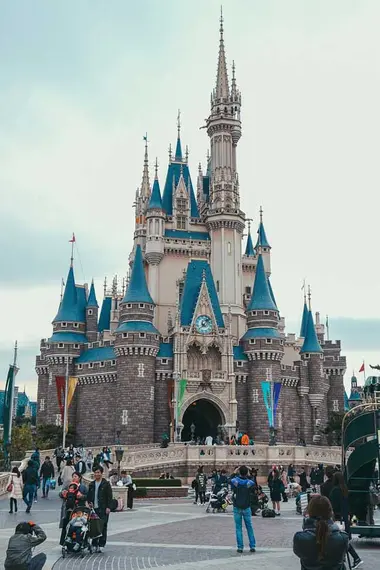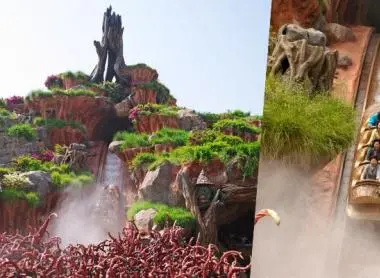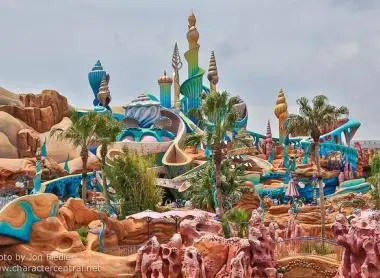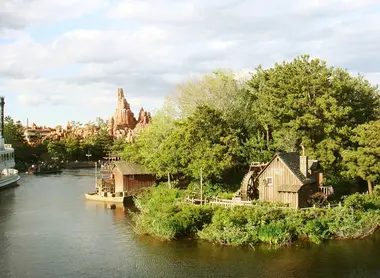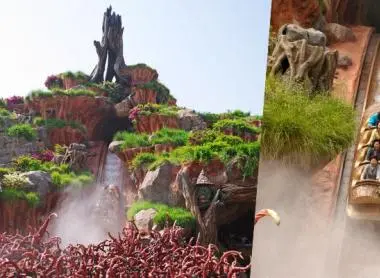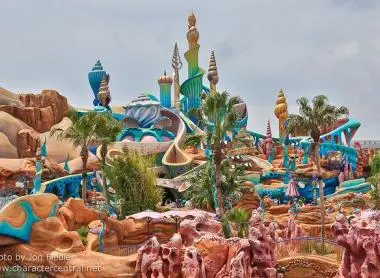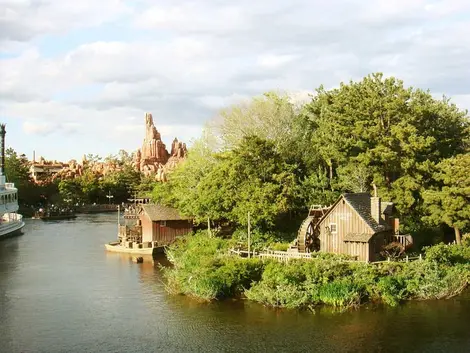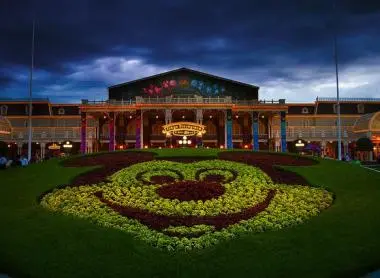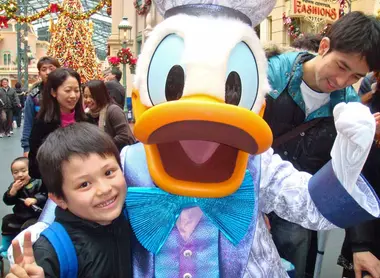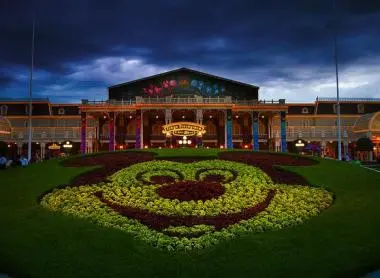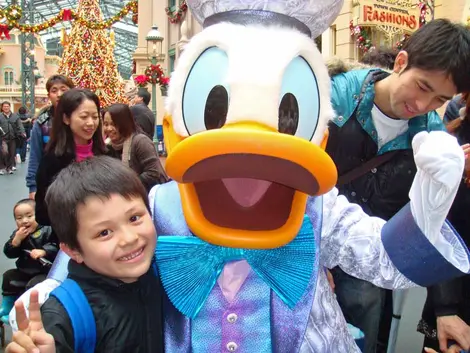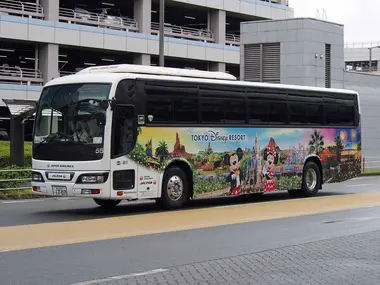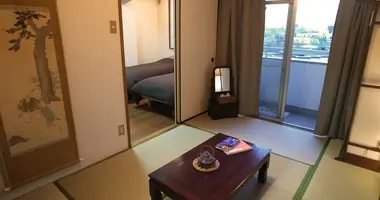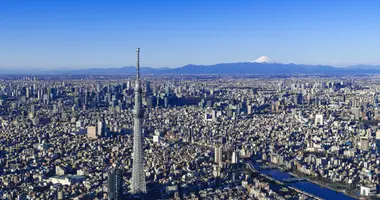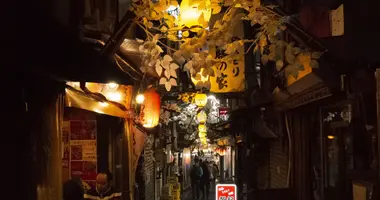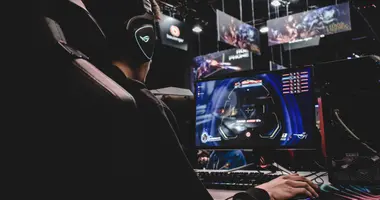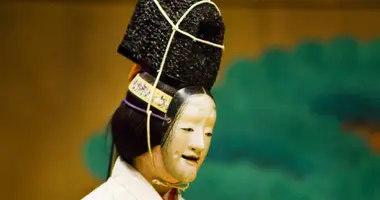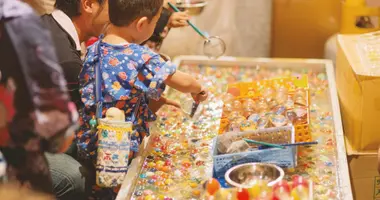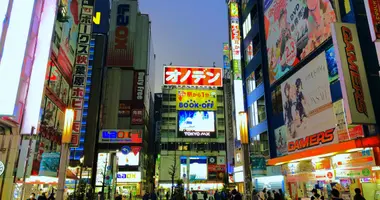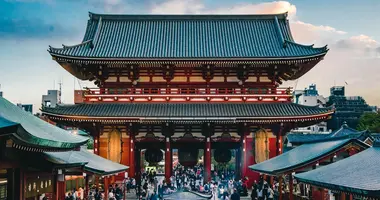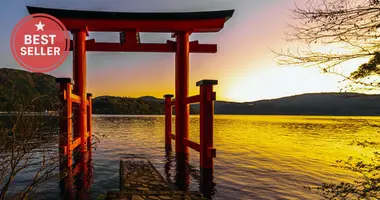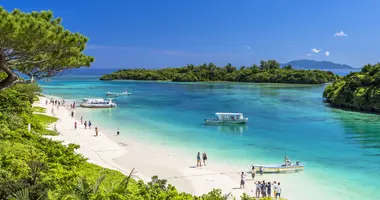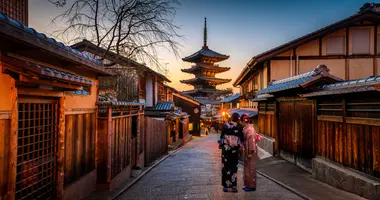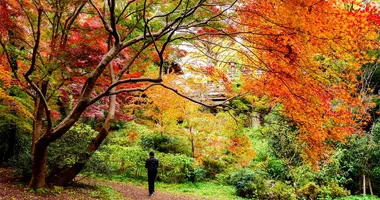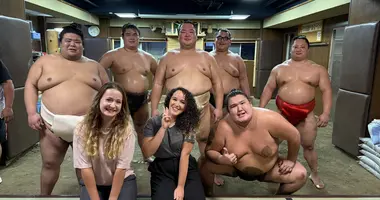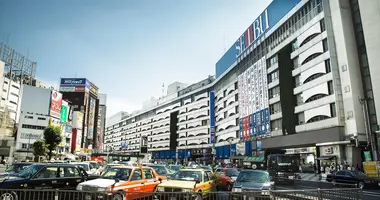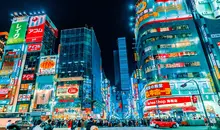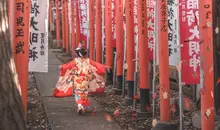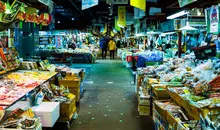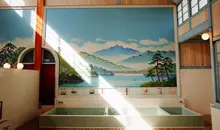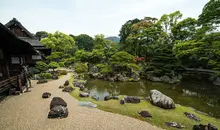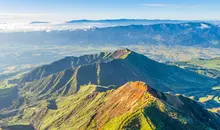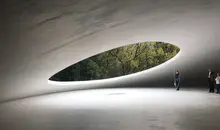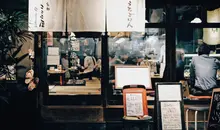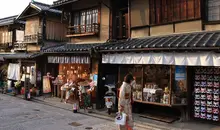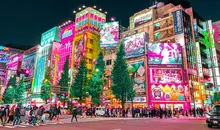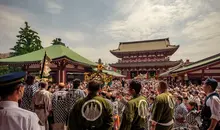Tokyo Disneyland: Das Königreich der Träume und der Magie in Japan
- Veröffentlicht am : 15/02/2025
- Von : Joshua
- Youtube
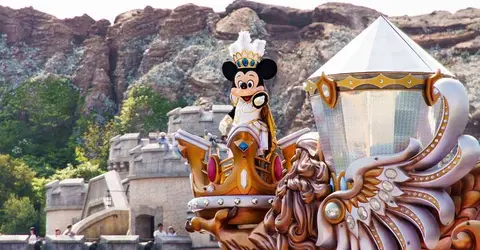
König Mickey in Tokio Disneyland
@Japan Visitor
Das in der Präfektur Chiba vor den Toren Tokios gelegene Tokyo Disneyland (東京ディズニーランド) ist der meistbesuchte Themenpark Japans und einer der beliebtesten der Welt. Er öffnete seine magischen Tore am 15. April 1983 und war der erste Disney-Park, der außerhalb der Vereinigten Staaten gebaut wurde, und hat sich seitdem zu einem kulturellen Phänomen in Japan entwickelt. Mit über einer Million Besuchern pro Monat, darunter viele aus China, Hongkong, Taiwan, Singapur und Südkorea, bietet Tokyo Disneyland eine einzigartige Mischung aus klassischem Disney-Zauber und unverkennbar japanischen Kulturelementen. Ganz gleich, ob Sie Ihren ersten Besuch planen oder zurückkehren, um die Magie neu zu entdecken, Tokyo Disneyland verspricht eine unvergessliche Reise durch sieben Themenländer voller bezaubernder Attraktionen, spektakulärer Unterhaltung und eindringlicher Erlebnisse.
Überblick und Geschichte von Tokyo Disneyland
Tokio Disneyland wurde 1983 als erster Disney-Themenpark außerhalb der Vereinigten Staaten eröffnet. Im Gegensatz zu anderen Disney-Parks auf der ganzen Welt wird der Park von der Oriental Land Company und nicht von der Walt Disney Company betrieben, die das geistige Eigentum lizenziert. Diese einzigartige Geschäftsvereinbarung hat zu dem besonderen Charakter und dem bemerkenswerten Erfolg von Tokyo Disneyland beigetragen.
Die Idee, ein japanisches Disneyland zu bauen, geht auf die späten 1950er Jahre zurück, als der Geschäftsmann Kunizo Matsuo an Walt Disney herantrat, um einen Disney-Park in Nara zu eröffnen. Dieser ursprüngliche Plan kam zwar nicht zustande, aber der Traum blieb bestehen. Im Februar 1974 lud die Oriental Land Company Disney-Führungskräfte offiziell nach Japan ein, und im April 1979 wurde nach jahrelangen Verhandlungen der Vertrag für den Bau von Tokyo Disneyland unterzeichnet. Der Park wurde auf einem 115 Hektar großen Grundstück errichtet, das in den 1960er Jahren als Erholungsgebiet ausgewiesen worden war, um der wachsenden Nachfrage nach Unterhaltungsmöglichkeiten im Großraum Tokio gerecht zu werden.
Die Bauarbeiten begannen 1980 und wurden von Hunderten von Reportern aufmerksam verfolgt, was auf die hohen Erwartungen an den Park hindeutet. Die endgültigen Kosten beliefen sich auf 180 Milliarden Yen und überstiegen damit die ursprünglich veranschlagten 100 Milliarden Yen erheblich. Als Tokyo Disneyland schließlich seine Pforten öffnete, war es ein sofortiger Erfolg und wurde von einigen als "das wichtigste kulturelle Ereignis der achtziger Jahre in Japan" bezeichnet
Bis 1994 hatten über 149 Millionen Menschen Tokyo Disneyland besucht - mehr als die gesamte Bevölkerung Japans zu dieser Zeit. Dieser phänomenale Erfolg führte zur Eröffnung von Tokyo DisneySea im Jahr 2001, das sich mit rund einer Million Besuchern pro Monat zum viertmeistbesuchten Themenpark der Welt entwickelt hat. Zusammen bilden diese Parks das Tokyo Disney Resort, das für viele junge Japaner als "Initiationsritus" gilt.
Parkanlage und Themenbereiche
Tokio Disneyland ist ein sorgfältig konzipierter Park mit sieben verschiedenen Themenbereichen, die jeweils einzigartige Attraktionen, Restaurants und Einkaufsmöglichkeiten bieten. Obwohl der Park vom ursprünglichen Disneyland in Kalifornien inspiriert ist, befindet sich in seinem Zentrum das Aschenputtel-Schloss, ähnlich wie in Walt Disney World in Florida.
Der World Bazaar ist der Haupteingang und der wichtigste Einkaufsbereich. Im Gegensatz zur Main Street, U.S.A., die man in anderen Parks im Stil des Magic Kingdom findet, ist der World Bazaar vollständig von einem gläsernen Wintergartendach im viktorianischen Stil umgeben, das die Gäste vor dem manchmal unberechenbaren Wetter in Japan schützt. Dieser Bereich besteht aus zwei sich kreuzenden Straßen: Die Main Street, die vom Eingang zum Cinderella Castle führt, und die Center Street, die in einer Richtung zum Adventureland und in der anderen zum Tomorrowland führt.
Adventureland kombiniert zwei verschiedene Themen: einen von New Orleans inspirierten Bereich und einen Bereich mit Dschungel-Thema. Dieses Land leiht sich Elemente sowohl vom New Orleans Square als auch vom Adventureland in den amerikanischen Disney-Parks aus und schafft so eine einzigartige Verschmelzung der Stile. Hier können die Gäste Attraktionen wie Pirates of the Caribbean, den Enchanted Tiki Room mit Stitch und die Western River Railroad, die Teile des Parks umrundet, erkunden.
Das Westernland (das Äquivalent zum Frontierland in anderen Disney-Parks) fängt den Geist des alten amerikanischen Westens ein. Dieser Bereich wird vom Big Thunder Mountain und den Rivers of America dominiert und bietet das Mark Twain Riverboat und zahlreiche animatronische Tiere, die die Wildnis zum Leben erwecken.
Critter Country, ein kleiner Bereich, der an das Westernland angrenzt, beherbergt Splash Mountain, eine Wasserrutsche, die auf Disneys Film Song of the South von 1946 basiert. Im Gegensatz zu seinen amerikanischen Pendants, die neu gestaltet wurden, bleibt der Splash Mountain in Tokio in seiner ursprünglichen Form erhalten, was ihn zu einem einzigartigen Erlebnis für internationale Besucher macht.
Das Fantasyland, das Herzstück eines jeden Disney-Parks, betritt man durch das Cinderella Castle - eine nahezu exakte Nachbildung des Schlosses in Floridas Magic Kingdom. Jüngste Erweiterungen haben einen Unterbereich für die Schöne und das Biest hinzugefügt, der die dunkle Fahrt "Enchanted Tale of Beauty and the Beast", Belle's Village mit Geschäften und Essensmöglichkeiten sowie das Fantasyland Forest Theatre mit der Show "Mickey's Magical Music World" umfasst.
Toontown, inspiriert durch den Film "Wer hat Roger Rabbit gerahmt", stellt einen Cartoon-Vorort nach, in dem Disney-Figuren "leben" Das Land verfügt über Roger Rabbit's Car Toon Spin und Minnie's Style Studio, einen 2020 hinzugefügten Begrüßungsbereich, in dem die Gäste Fotos mit Minnie Mouse in saisonal wechselnden Outfits machen können.
Das Tomorrowland setzt eher auf Science-Fiction-Fantasie als auf eine realistische Vision der Zukunft. Zu den jüngsten Erweiterungen gehören The Happy Ride with Baymax, die erste Disney-Attraktion zum Film Big Hero 6 von 2014, und The Big Pop, ein Popcorn-Laden mit Weltraumthema. Demnächst werden in diesem Bereich eine Wreck-It Ralph-Attraktion und ein völlig neu gestalteter Space Mountain eröffnet, der für 2027 erwartet wird.
Attraktionen und Unterhaltungsangebote
Tokyo Disneyland verfügt über ein beeindruckendes Angebot an Attraktionen, das Disney-Klassiker mit einzigartigen Erlebnissen kombiniert, die es nur in Japan gibt. Viele Fahrgeschäfte werden Besuchern amerikanischer Disney-Parks bekannt vorkommen, doch die Tokioter Versionen zeichnen sich oft durch eine verbesserte Thematisierung, eine bessere Wartung und manchmal durch eine andere Handlung aus.
Zu den exklusiven Attraktionen, die man unbedingt gesehen haben muss, gehört Pooh's Hunny Hunt, die erste Disney-Fahrt, die mit gleisloser Technologie arbeitet. Diese bahnbrechende, dunkle Fahrt führt die Gäste in Honigtöpfen, die durch die Szenen zu tanzen scheinen, durch den Hundertmorgenwald und bietet ein völlig anderes Erlebnis als die Winnie-the-Pooh-Attraktionen in anderen Disney-Parks.
Monsters Inc. Ride & Go Seek ist ein weiteres Original in Tokyo Disneyland, das seine amerikanischen Pendants übertrifft. Bei diesem interaktiven Dark Ride können die Gäste mit Hilfe von Taschenlampen animatronische Effekte in ganz Monstropolis aktivieren und so ein überraschendes und vergnügliches Erlebnis schaffen, ohne wie bei anderen interaktiven Attraktionen Punkte zu zählen.
Die neueste Attraktion, Enchanted Tale of Beauty and the Beast, wird 2020 im Rahmen der größten Erweiterung von Tokyo Disneyland eröffnet. Diese gleislose, dunkle Fahrt lädt die Gäste ein, in magische Teetassen zu steigen, die durch das Schloss der Bestie tanzen und die geliebte Geschichte mit beeindruckenden Audio-Animatronics und beeindruckenden Showszenen zum Leben erwecken.
Zu den klassischen Attraktionen, die in Tokyo Disneyland verbessert wurden, gehören Space Mountain (das allerdings bis 2027 komplett umgebaut wird), Splash Mountain (das weiterhin in seiner ursprünglichen Form betrieben wird) und das Country Bear Jamboree (das in seiner vollständigen, ungekürzten Version präsentiert wird).
Das Unterhaltungsangebot von Tokyo Disneyland ist ebenso beeindruckend und bietet einige der aufwändigsten Paraden und Shows in allen Disney-Parks weltweit. Die aktuelle Tagesparade "Disney Harmony in Color" zeigt Figuren aus Filmen wie Zootopia, Moana und Coco auf farbenfrohen Wagen, die eine Welt voller Farben und Harmonie zelebrieren.
Das nächtliche Spektakel "Reach for the Stars" im Cinderella Castle kombiniert Projection Mapping, Beleuchtung, Pyrotechnik und Spezialeffekte zu einer atemberaubenden Show, in der geliebte Disney-Figuren ihre Träume verwirklichen.
Saisonale Veranstaltungen und zeitlich begrenzte Feste bieten das ganze Jahr über neue Erlebnisse für wiederkehrende Besucher. Dazu gehören Halloween, Weihnachten, Silvester, Disney Pal-Palooza-Veranstaltungen und andere besondere Feste, die den Park mit einzigartigen Dekorationen, Unterhaltungsangeboten und thematischen Speisen verwandeln.
Praktische Informationen für Besucher
Die Planung eines Besuchs in Tokyo Disneyland erfordert einige Vorbereitungen, insbesondere für internationale Reisende. Hier finden Sie die wichtigsten Informationen, die Ihnen helfen, Ihr Erlebnis magisch zu machen:
Betriebszeiten:
Montag - Freitag: 9 Uhr bis 22 Uhr
Samstag: 8.00 bis 22.00 Uhr
Sonntag und Feiertage: 8 Uhr (manchmal 9 Uhr) bis 22 Uhr
Diese Zeiten können je nach Saison und bei besonderen Veranstaltungen variieren. Schauen Sie im Tokyo Disneyland Crowd Calendar nach, um die Öffnungszeiten des Parks und die Vorhersage der Besucherzahlen für bestimmte Daten zu erfahren.
Eintrittskarten:
Die Eintrittspreise sind für Tokyo Disneyland und Tokyo DisneySea identisch. Tickets können online über die offizielle Website, in den Parks, in Geschäften in ganz Japan, in großen Reisebüros, an JR-Schaltern und in ausgewählten Geschäften erworben werden.
Es sind verschiedene Ticketoptionen erhältlich, darunter 1-Tages-Pässe, Mehrtagespässe und spezielle Pakete. Die Preise sind in der Regel erschwinglicher als in den amerikanischen Disney-Parks, wobei die Preise für 1-Tages-Tickets zwischen 55 und 65 $ liegen.
Verkehrsmittel:
Mit dem Zug: Vom Bahnhof Tokio nehmen Sie die JR Keiyo Line oder die JR Musashino Line (ca. 15 Minuten) und steigen am JR Maihama Bahnhof (Südausgang) aus.
Mit dem Bus: Direkte Busse fahren von mehreren Orten aus:
- Busta Shinjuku (ca. 1 Stunde)
- Ostausgang des Bahnhofs Yokohama (ca. 1 Stunde)
- Kawasaki Station Ostausgang (ca. 65 Minuten)
- Urayasu Station(U-Bahnlinie Tokyo Metro Tozai) - Stadtbus - (ca. 25 Minuten)
Keisei Bus Company und JR bieten Busse zum Tokyo Disney Resort von Busta Shinjuku an. Siehe den Fahrplan Keisei Bus Shinjuku-Tokyo Disney Resort. Prepaid-Karten wie Pasmo und Suica können in diesen Direktbussen nicht verwendet werden.
Es gibt auch Direktbusse vom Flughafen Narita (ca. 1 Stunde), vom Flughafen Haneda (ca. 50 Minuten), vom Bahnhof Akihabara (35 Minuten) und Fernbusse vom Bahnhof Nagoya, vom Bahnhof Kyoto und von anderen wichtigen Zielen.
Innerhalb des Resorts:
Die Einschienenbahn Disney Resort Line verbindet Tokyo Disneyland, Tokyo DisneySea, die Bayside Station (für die offiziellen Hotels) und das Einkaufszentrum Ikspiari. Eine einfache Fahrt kostet 250 Yen für Erwachsene und 130 Yen für Kinder, oder Sie können eine Tageskarte erwerben. Alternativ ist die Fahrt mit dem Resort Cruiser-Bus im Stil der 1930er Jahre kostenlos.
Beste Zeit für einen Besuch:
Wochentage außerhalb der japanischen Schulferien und Feiertage sind im Allgemeinen weniger überlaufen. Der Tokyo Disneyland Crowd Calendar ist eine unschätzbare Hilfe bei der Planung. Die geschäftigsten Zeiten sind die Goldene Woche (Ende April bis Anfang Mai), Obon (Mitte August) und Neujahr.
Das Erlebnis Tokyo Disney Resort
Das Erlebnis Tokio Disney Resort geht über die Themenparks hinaus und umfasst ein komplettes Urlaubsziel mit Hotels, Einkaufsmöglichkeiten, Restaurants und Unterhaltungsangeboten.
Die offiziellen Disney-Hotels bieten das intensivste Erlebnis und umfassen:
- Tokyo Disneyland Hotel: Dieses Luxushotel im viktorianischen Stil befindet sich am Eingang von Tokyo Disneyland und bietet elegante Unterkünfte mit Disney-Figuren.
- Disney Ambassador Hotel: Dieses Hotel im Art-déco-Stil und mit Hollywood-inspirierter Thematisierung liegt in der Nähe des Ikspiari-Einkaufskomplexes.
- Hotel MiraCosta: Dieses mediterran gestaltete Luxushotel in Tokyo DisneySea bietet Zimmer mit Blick auf den Park - ein einzigartiges Erlebnis.
- Toy Story Hotel: Dieses neuere Hotel der mittleren Kategorie erweckt die Welt von Toy Story mit Zimmern, die wie Andys Schlafzimmer aussehen, zum Leben.
- Fantasy Springs Hotel: Das neueste Luxushotel mit Blick auf den Fantasy Springs-Bereich von Tokyo DisneySea.
Zu den offiziellen Partnerhotels an der Monorail-Schleife gehören das Hilton Tokyo Bay, das Sheraton Grande Tokyo Bay Hotel, das Hotel Okura Tokyo Bay und weitere Hotels, die einen bequemen Zugang zu oft günstigeren Preisen bieten.
Für Shoppingbegeisterte bietet der Ikspiari-Komplex über 140 Geschäfte, Restaurants und Unterhaltungsmöglichkeiten, ähnlich wie Disney Springs in Walt Disney World. Innerhalb der Parks bietet jedes Themenland einzigartige Waren an, wobei Tokyo Disneyland besonders für seine große Auswahl an Waren der Figuren, saisonalen Artikeln und exklusiven Duffy & Friends-Produkten bekannt ist, die nirgendwo anders zu finden sind.
Das Essen im Tokyo Disney Resort ist ein Abenteuer für sich, mit Optionen, die von Schnellrestaurants bis hin zu aufwendigen Themenrestaurants reichen. Japanische Adaptionen amerikanischer Lieblingsgerichte stehen neben traditioneller japanischer Küche und einzigartigen Fusionsangeboten. Das Resort ist berühmt für seine Vielfalt an aromatisierten Popcorns, saisonalen Desserts und Snacks in Form von Figuren, die ebenso fotogen wie lecker sind.
Was das Tokyo Disney Resort wirklich auszeichnet, ist der tadellose Service und die Liebe zum Detail. Die Mitarbeiter sind außerordentlich zuvorkommend und bemüht, magische Erlebnisse zu schaffen. Die Parks sind makellos gepflegt, von den Attraktionen bis zur Landschaftsgestaltung ist alles in tadellosem Zustand. Dieses Engagement für Spitzenleistungen ist ein Markenzeichen der japanischen Kultur, das das gesamte Tokio-Disney-Erlebnis aufwertet.
Kulturelle Anpassungen und einzigartige Merkmale
Was Tokyo Disneyland besonders faszinierend macht, ist die Art und Weise, wie es das eindeutig amerikanische Konzept von Disney an die japanische Kultur angepasst hat, ohne dabei den Kern des Disney-Zaubers zu verlieren. Dieses empfindliche kulturelle Gleichgewicht war der Schlüssel zum außerordentlichen Erfolg des Parks.
Im Gegensatz zu Disneyland Paris, das anfangs als "kulturelles Tschernobyl" auf Widerstand stieß, wurde Tokio Disneyland von der japanischen Gesellschaft von Anfang an akzeptiert. Der Park ist das, was Kulturanthropologen ein Paradebeispiel für "Glokalisierung" nennen - die Anpassung globaler Produkte an lokale Märkte - und nicht einfach nur für kulturellen Imperialismus.
Tokio Disneyland behauptet zwar, eine "100-prozentige Kopie" des amerikanischen Originals zu sein, aber subtile, aber signifikante Anpassungen machen es einzigartig japanisch:
Die in Japan weit verbreitete "kawaii"-Kultur (niedlich) ist in der gesamten Anlage stark vertreten. Am deutlichsten wird dies an der außerordentlichen Popularität von Duffy dem Bären und seinen Freunden, die in Japan einen Kultstatus erreicht haben, der weit über den hinausgeht, den sie in Amerika je hatten. Der Schwerpunkt auf niedlichen Figuren, Desserts und Fotomöglichkeiten passt perfekt zu diesem Aspekt der japanischen Kultur.
Das Unterhaltungsprogramm ist an den japanischen Geschmack angepasst, wobei ruhigere, zurückhaltende Publikumsreaktionen bis zu den vorgesehenen Applausmomenten die Norm sind. Die Paraden sind geordneter, und die Gäste sitzen in der Regel in ordentlichen Reihen auf dem Boden, anstatt zu stehen. Die Paraden und Shows in Tokyo Disneyland sind aufwändiger und häufiger als ihre amerikanischen Pendants, was die hohe Wertschätzung der japanischen Besucher für hochwertige Unterhaltung widerspiegelt.
Das Essensangebot ist eine Mischung aus westlichen und japanischen Einflüssen, mit einzigartigen Gerichten wie Curry-Popcorn, Teriyaki-Hühnerbeinen und gedämpften Brötchen in Mickey-Form mit japanischen Füllungen. Die Portionen sind in der Regel kleiner, und der Präsentation wird besondere Aufmerksamkeit gewidmet, mit saisonalen und charakteristischen Speisen, die ebenso schön wie lecker sind.
Selbst klassische Attraktionen werden kulturell angepasst. Die Dschungel-Kreuzfahrt zum Beispiel hat ein japanisches Skript, das mit lokalen Witzen gefüllt ist und nicht mit amerikanischen Witzeleien. Country Bear Jamboree wird in seiner vollständigen, ungeschnittenen Fassung präsentiert, da das japanische Publikum eine andere kulturelle Perspektive auf den Inhalt hat.
Tokyo Disneyland hat sich auch zu einem wichtigen Ausflugsziel entwickelt, das besonders bei jungen "Bürodamen" (junge Frauen, die in Büroberufen arbeiten) beliebt ist. Der Park macht sich das japanische Konzept des "kawaiiko burikko" (so tun, als sei man ein niedliches Kind) zunutze, das bei jungen Frauen ein beliebter Ausdrucksstil ist. Etwa 30 % der wiederkehrenden Besucher von Tokyo Disneyland sind "Bürofrauen", wobei viele ein Disney-Date als Zeichen einer ernsthaften Beziehungsinvestition betrachten.
Zukünftige Entwicklungen und Erweiterungen
Das Tokyo Disney Resort entwickelt sich ständig weiter und es stehen spannende Entwicklungen an. Die Oriental Land Company hat sich verpflichtet, Milliarden von Yen in Erweiterungsprojekte zu investieren, die die Zukunft der beiden Parks prägen werden.
Das bedeutendste Projekt in Tokyo Disneyland ist die komplette Neugestaltung des Space Mountain und des ihn umgebenden Tomorrowland, das 2027 eröffnet werden soll. Mit einer Investition von rund 56 Milliarden Yen (fast 500 Millionen Dollar) wird dieses Projekt das ursprüngliche Konzept einer Indoor-Achterbahn beibehalten, jedoch mit verbesserter Leistung und beeindruckenden Spezialeffekten ausgestattet. Es wird erwartet, dass die umgebaute Attraktion ähnlich wie Guardians of the Galaxy sein wird: Cosmic Rewind im EPCOT, mit einem größeren Schwerkraftgebäude und einem geschichtenorientierten Erlebnis, allerdings ohne die Verbindung zu Marvel.
Der neue Tomorrowland-Platz soll die Verbindung zwischen der Erde und dem Universum zum Ausdruck bringen und eine Zukunft darstellen, in der die Menschen in Harmonie mit der Natur leben. Nach Angaben von The Oriental Land Company wird dieser neu gestaltete Bereich den Gästen Momente der Ruhe und Entspannung inmitten von Designelementen bieten, die ein Gefühl der Hoffnung für die Zukunft vermitteln.
Eine weitere wichtige Neuerung in Tokyo Disneyland wird die interaktive Indoor-Spielattraktion Wreck-It Ralph sein, die das bestehende Fahrgeschäft Buzz Lightyear's Astro Blasters neu interpretiert. Voraussichtlich im oder nach dem April 2026 wird dieses neue Erlebnis die Gäste in das Süßigkeiten-Rennspiel Sugar Rush einladen, das von den Sugar Bugs von King Candy angegriffen wird. Die Gäste werden sich mit Ralph und Vanellope zusammentun, um diese Glitches wieder in ihre ursprüngliche "kawaii"-Süßwarenform zu verwandeln.
Die saisonalen Veranstaltungen werden weiter aufgefrischt: Das kürzlich eingeführte Disney Pal-Palooza-Konzept wird voraussichtlich vom 15. Januar bis 16. März 2025 zurückkehren. Außerdem werden vom 15. Januar bis zum 30. Juni 2025 Figuren aus dem Marvel Cinematic Universe in der Attraktion "It's a Small World with Groot" zu sehen sein - der erste Auftritt von Marvel-Figuren in einer Attraktion des Tokyo Disney Resorts.
Tokyo DisneySea hat vor kurzem seine größte Erweiterung mit der Eröffnung von Fantasy Springs im Juni 2024 abgeschlossen, mit Attraktionen, die auf Frozen, Tangled und Peter Pan basieren, sowie dem neuen Fantasy Springs Hotel. Dieses 320-Milliarden-Yen-Projekt stellt die größte Investition in einem Disney-Park weltweit dar und setzt hohe Maßstäbe für zukünftige Entwicklungen.
Da das Tokyo Disney Resort im Jahr 2028 sein 45-jähriges Bestehen feiert, zeigen diese Erweiterungen und Renovierungen das Engagement von The Oriental Land Company, das Resort an der Spitze der weltweiten Themenpark-Erlebnisse zu halten. Das Unternehmen hält weiterhin die Balance zwischen der Beibehaltung klassischer Disney-Traditionen und der Einführung innovativer Attraktionen sowie der Einbeziehung von Elementen, die die japanische Kultur und Vorlieben widerspiegeln.
Mit seiner Mischung aus Disney-Magie, tadellosem Service, kulturellen Anpassungen und ständiger Weiterentwicklung bleibt Tokyo Disneyland ein Zeugnis für die universelle Anziehungskraft der Disney-Geschichten und die erfolgreiche Verbindung amerikanischer Unterhaltungskonzepte mit japanischem Feingefühl. Für Besucher aus aller Welt bietet es nicht nur ein Themenparkerlebnis, sondern eine einzigartige kulturelle Reise durch das Königreich der Träume und der Magie.
Adresse - Ankunftszeit - Anfahrt
Addresse
1-1 Maihama
2798511
Japan
